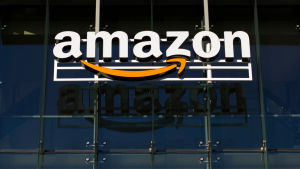Entering a bull market wasn’t a linear journey. With the market shift from a 2022 bear market, where safer stocks gained favor, to 2023’s confidence, it prompted a return to growth stocks.
Despite the S&P 500‘s 23% surge, some 2022 gainers declined in 2023. S&P 500 Pure Value rose 5%, while Nasdaq-100 tech jumped 52%. Amid the five-year market volatility and 2022’s macroeconomic challenges causing sell-offs, many prominent tech stock shares remain resilient and appealing for long-term investments.
Let’s examine three stocks that investors should buy and hold for the next five years.
Amazon (AMZN)

In the last two decades, Amazon (NASDAQ:AMZN) evolved from a small online bookstore to dominate e-commerce, expanding its product range through Amazon Marketplace. Introducing services like Amazon Prime, it then ventured into cloud computing with Amazon Web Services (AWS). It sustained impressive growth and became a preferred provider in the commercial sector.
Despite Amazon’s massive size limiting historical growth rates, it holds strong growth potential. In e-commerce, with a 38% U.S. market share and low overall retail share, expansion abounds, especially in India’s emerging market. The cloud computing industry benefits from ongoing cloud migration and AI advancements.
Amazon experienced double-digit sales growth, recording impressive 13% year-over-year (YOY) revenue growth in Q3 2023. Profits surged, with operating income quadrupling and net income tripling to $9.9 billion. The company’s commitment to innovation and customer satisfaction fosters a culture of experimentation. Additionally, it positions it well for sustained growth and adaptation to future trends.
Meta Platforms (META)

In 2023, Meta Platforms (NASDAQ:META) prioritized efficiency. Accordingly, 2024 presents opportunities for remarkable growth. Despite the stock’s surge, positive catalysts suggest further improvement and strong sales growth.
Meta faces a major risk in 2024 – the prospect of a U.S. recession, albeit mild. Various metrics signal challenges for the company, given its reliance on advertising revenue. Recessions, typically short-lived, do pose threats. However, Meta’s dominant social media presence remains a strength, as the company attracts more users and enhances its advertising pricing power.
Meta Platforms is nearing the $1 trillion market capitalization level, surging 200% in 2023. The company’s current market cap of more than $980 billion could easily reach this threshold in short order. If Meta rejoins the trillion-dollar club, and the stock trends toward new all-time highs, investors will be increasingly focused on forward-looking growth projections. At least for now, I expect projections to increase, due to the strong fundamentals of this company’s core business.
Restaurant Brands (QSR)

Canadian-based fast food giant Restaurant Brands International (NYSE:QSR), with brands like Burger King and Tim Hortons, reported robust Q2 FY2023 results.
The company yields 9.6% growth in comparable sales and increased EBITDA surged from $618 million in 2022 to $665 million in 2023. Importantly, QSR stock offers a 2.9% forward dividend yield, providing steady income via consistent dividend payments over the last five years.
In recent news, Restaurant Brands and Carrols Restaurant Group announced a deal. RBI will acquire all outstanding Carrols shares for $9.55 each in an all-cash transaction, valuing Carrols at approximately $1 billion. This represents a 23.1% premium to Carrols’ 30-day average price.
Tom Curtis, President of Burger King U.S. and Canada, expressed enthusiasm about acquiring Carrols. He aims to enhance guest experiences through rapid restaurant remodeling. Deborah Derby, Carrols’ President and CEO, highlighted the transaction’s immediate value for shareholders and growth opportunities for team members within Restaurant Brands.
For long-term investors betting on continued innovation and growth with this company, Restaurant Brands is positioned well for the next five years.
On the date of publication, Chris MacDonald did not have (either directly or indirectly) any positions in the securities mentioned in this article. The opinions expressed in this article are those of the writer, subject to the InvestorPlace.com Publishing Guidelines.

